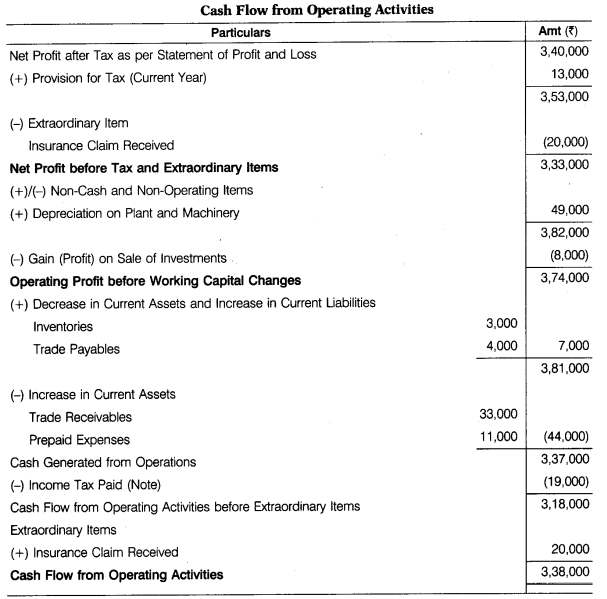Students must start practicing the questions from CBSE Sample Papers for Class 12 Accountancy with Solutions Set 5 are designed as per the revised syllabus.
CBSE Sample Papers for Class 12 Accountancy Set 5 with Solutions
Time :3 hrs
Max. Marks: 80
Instructions:
- This question paper contains 34 questions. All questions are compulsory.
- This question paper is divided into two parts, Part A and B.
- Part-A has Accounting for Partnership Firms and Companies.
- Part-B has Analysis of Financial Statements.
- Questions Nos. 1 to 16 and 27 to 30 carries 1 mark each.
- Questions Nos. 17 to 20, 31 and 32 carries 3 marks each.
- Questions Nos. from 21, 22 and 33 carries 4 marks each
- Questions Nos. from 23 to 26 and 34 carries 6 marks each
-
There is no overall choice. However, an internal choice has been provided in 7 questions of
one mark, 2 questions of three marks, 1 question of four marks and 2 questions of six marks.
Part A
(Accounting for Partnership Firms and Companies)
Question 1.
Sonu and Monu are partners sharing profits and losses in the ratio of 3: 2. Tonu is admitted for 1/5 th share in profits of the firm which he gets entirely from Sonu. Find out the new profit sharing ratio. [1]
(a) 12: 8: 5
(b) 8: 12: 5
(c) 2: 2: 1
(d) 2: 2: 2
Answer:
(c) Sonu’s share =3/5 – 1 / 5 = 2/5
Monu’s share =2/5; Tonu’s share = 1/5
New profit sharing ratio = 2: 2: 1
![]()
Question 2.
A company ‘Vansh Ltd’ has purchased an asset costing ₹ 22,00,000. Vendor issued 10 % debentures of ₹ 100 each at 10% premium as consideration against asset purchased.
Calculate number of debentures to be issued. [1]
(a) 26,000 debentures
(b) 24,000 debentures
(c) 20,000 debentures
(d) 22,000 debentures
Answer:
(c) Number of Debentures Issued = \(\frac{22,00,000}{110(100+10)}\) = 20,000 debentures.
Or
XYZ Ltd. called first call money of ₹ 3 per share on its 50,000 shares. A shareholder holding 2,750 shares failed to pay the amount. How much amount will be due on first call?
(a) ₹ 1,41,750
(b) ₹ 1,57,000
(c) ₹ 1,50,000
(d) ₹ 1,47,750
Answer:
(c) Call money is made due with the whole amount. As per question, ₹ 1,50,000(50,000 x 3) will be made due.
Question 3.
Total capital employed in the firm is ₹ 4,00,000, reasonable rate of return is 15 % and profit for the year is ₹ 6,00,000. The value of goodwill of the firm as per capitalisation method would be
(a) ₹ 41,00,000
(b) ₹ 6,00,000
(c) ₹ 36,00,000
(d) ₹ 21,00,000
Answer:
(c) Capitalised Value of Profits = \(\frac{\text { Average Profits }}{\text { Normal Rate of Return }}\) x 100=\(\frac{6,00,000}{15}\) x 100 = ₹ 40,00,000
Goodwill = Capitalised Value of Profits – Actual Capital Employed
= 40,00,000 – 4,00,000 = ₹ 36,00,000
![]()
Question 4.
Vijay, a director of the company proposed in a board meeting that to inculcate the habit of savings among people, he wanted to bring a special issue of shares. His proposal was accepted by the company. The company issued 35,000 shares of ₹ 100 each, payable ₹ 30 on application, ₹ 50 on allotment and ₹ 20 on call. Tarun, a shareholder holding 25 shares could not pay his call money and Arjun another shareholder holding 30 shares paid the call money with allotment. Tarun, paid the amount due to him after four months explaining the reason for this delay, the company did not charge any interest from him. Calculate the amount received by the company on allotment.
(a) ₹ 17,50,000
(b) ₹ 10,50,000
(c) ₹ 17,50,600
(d) ₹ 24,50,000
Answer:

Question 5.
A, B and C are partners sharing profits and losses in the ratio of \(\frac{4}{10}\), \(\frac{4}{10}\) and \(\frac{1}{5}\). B retires from the firm, A and C decided to share future profits and losses in the ratio of 3: 2. Calculate gaining ratio. [1]
(a) 1: 2
(b) 1: 1
(c) 3: 2
(d) 2: 1
Answer:
(b) Gaining ratio = New share – Old share
Gaining ratio of A = \(\frac{3}{5}-\frac{4}{10}=\frac{6-4}{10}=\frac{2}{10}\) and Gaining ratio of C= \(\frac{2}{5}-\frac{1}{5}=\frac{1}{5} \times \frac{2}{2}=\frac{2}{10}\)
∴ Gaining ratio = \(\frac{2}{10}: \frac{2}{10}\) or 2: 2, i.e. 1: 1.
Question 6.
Which of the following statements is incorrect about essential features of partnership?
(a) There must be an agreement
(b) There must be a business
(c) The business must be carried on for profits
(d) The business must be carried on by all the partners
Answer:
(d) The business must be carried on by all or any of them acting for all.
Or
At the time of change in profit sharing ratio, workmen compensation reserve existing in the balance sheet against which no liabilities exist, is transferred to capital account of partners in their
(a) old profit sharing ratio
(b) new profit sharing ratio
(c) sacrificing ratio
(d) gaining ratio
Answer:
(a) old profit sharing ratio
Question 7.
Net profit is always taken after …… in the profit and loss appropriation account.
(a) interest on partner’s loan
(b) manager’s commission
(c) Both (a) and (b)
(d) None of the above
Answer:
(c) Both (a) and (b)
Or
When partners’ capital accounts are fixed, which one of the following items will be written in the partner’s capital account?
(i) Partner’s drawings
(ii) Additional capital introduced by the partner in the firm
(iii) Loan taken by partner from the firm
(iv) Loan advanced by partner to the firm Codes
(a) (i) and (ii)
(b) (iii) and (iv)
(c) Only (ii)
(d) (i) and (iii)
Answer:
(c) When fixed capital accounts are maintained, additional capital introduced and withdrawal of capital are recorded in capital account. Rest of the transactions are recorded in current account.
![]()
Question 8.
P, Q and R are partners sharing profits in the ratio of 3: 2: 1. They agree to admit Z into the firm. P, Q and R agreed to give 1/3rd, 1/6 th and 1/9th share of their profit. The share of profit of Z will be [1]
(a) 11/54
(b) 13/54
(c) 1/10
(d) 12/54
Answer:
(b) Z’s share =3/6 x 1/3+2/6 x 1/6+1/6 x 1/9 = 3/18+2/36+1/54=18+6+2/108=13/54
Question 9.
During the year 2022-23, Network 10 Ltd. issued 12 % debentures of ₹ 100 each as per the details given. A machine was purchased for ₹ 2,18,500. The vendor was paid by the issue of 1,900 debentures at a premium of 15%, to be redeemed at par. The entry for the payment will be …………………….. [1]
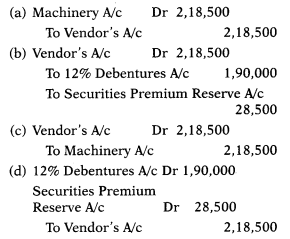
Or
On 28th February, 2022, the first call of ₹ 2 per share became due on 25,000 equity shares allotted by Walmart Ltd. Raju, a holder of 500 shares did not pay the first call money.
Bhanu, a holder of 375 shares paid the second and final call of ₹4 per share along with the first call. Journal entry for the amount received will be…………….
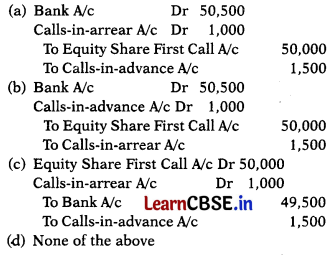
Answer:

Question 10.
Total capital specified in capital clause is ₹ 50,00,000 which is divided in 35,000 equity shares of ₹ 100 each and 15,000, 10% preference shares of ₹ 100 each. The company issued 10,000 equity shares and 5,000 preference shares. The public subscribed for 9,000 equity shares and 4,500 preference shares out of the issued shares. What will be the subscribed capital amount?
(a) ₹ 50,00,000
(b) ₹ 50,000
(c) ₹ 9,00,000
(d) ₹ 13,50,000
Direction Read the following hypothetical situation and answer Q. No. 11 and 12 X and Y are partners in a firm. X gets commission of 10% on the net profits before charging any commission and Y gets commission of 10% on the net profits after charging all commission.
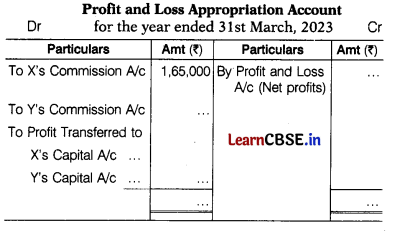
Answer:
(d) Subscribed capital amount will be the amount corresponding to shares which have been subscribed by public,

![]()
Question 11.
Net profit before charging commission will be ………….
(a) ₹ 1,65,000
(b) ₹ 16,00,000
(c) ₹ 16,50,000
(d) ₹ 15,00,000
Answer:
(c) Commission 10% on the net profit before charging any commission =₹ 1,65,000
∴ Net profit before charging any commission = 1,65,000 x \(\frac{100}{10}\) = ₹ 16,50,000
Question 12.
Y’s commission will be ……….
(a) ₹ 1,65,000
(b) ₹ 1,35,000
(c) ₹ 1,48,500
(d) ₹ 1,50,000
Answer:
(b) Net profit after charging X’s commission = 16,50,000-1,65,000 = ₹ 14,85,000
Y’s Commission = 14,85,000 x \(\frac{10}{110}\) = 1,35,000
Question 13.
Assertion A) Minimum subscription is the minimum amount which must be subscribed by the public.
Reason (R) Minimum subscription has been fixed at 80 % of the issued amount. [1]
Alternatives
(a) Both Assertion (A) and Reason (R) are true and teason (R) is the correct explanation of Assertion (A)
(b) Both Assertion (A) and Reason (R) are true, but Reason (R) is not the correct explanation of Assertion (A)
(c) Assertion (A) is true, but Reason (R) is false
(d) Assertion (A) is false, but Reason (R) is true
Answer:
(c) As per Companies Act, minimum subscription has been fixed at 90% of the issued amount.
Question 14.
Assertion (A) Partnership agreement in writing is considered as desirable.
Reason (R) Written partnership agreement serves as evidence in the court of law. [1]
Alternatives
(a) Both Assertion (A) and Reason (R) are true and Reason (R) is the correct explanation of Assertion (A)
(b) Both Assertion (A) and Reason (R) are true, but Reason (R) is not the correct explanation of Assertion (A)
(c) Assertion (A) is true, but Reason (R) is false
(d) Assertion (A) is false, but Reason (R) is true
Answer:
(a) Both Assertion (A) and Reason (R) are true and Reason (R) is the correct explanation of Assertion (A).
![]()
Question 15.
A and B are partners sharing profits equally. Interest on A’s drawings is ₹ 3,250 and B’s drawings is ₹ 2,750.10% of distributable profit is transferred to reserve fund. Profit for the year is ₹ 10,00,000. Amount transferred to reserve fund will be
(a) ₹ 1,00,000
(b) ₹ 1,00,600
(c) ₹ 1,00,300
(d) ₹ 99,400
Answer:
(b) Transferred to reserve fund = (10,00,000+3,250)+2,750 x 10% = ₹ 1,00,600
Question 16.
X and Y are partners in a firm sharing profits and losses in the ratio of 5:7 respectively. Their balance sheet shows creditors at ₹ 1,00,000. If creditors amounting to ₹ 12,000 are to be written-off as they are not likely to be claimed, what will be the new value of creditors to be shown in new balance sheet? [1]
(a) ₹ 12,000
(b) ₹ 1,12,000
(c) ₹ 88,000
(d) None of these
Answer:
(c) New value of creditors = 1,00,000-12,000 = ₹ 88,000
Or
A and B are partners sharing profits and losses as 2: 1. C is admitted and profit sharing ratio becomes 4: 3: 2. Goodwill is valued at ₹ 94,500. C brings required goodwill in cash. Goodwill amount will be credited to
(a) A ₹ 14,000 and B ₹ 7,000
(b) A ₹ 12,000 and B ₹ 9,000
(c) A ₹ 21,000
(d) A ₹ 94,500
Answer:
(c) Sacrificing Ratio $=$ Old Share – New Share
A = 2/3 – 4/9 = 6-4/9 = 2/9; B = 1/3-3 /9 = 3-3/9 = Nil
C’s share in goodwill 94,500 x 2/9 = ₹ 21,000 will be sacrificed only by A
Question 17.
Dukes Ltd issued 5,000 shares of ₹ 10 each credited as fully paid to the promoters for their services and issued 4,000 shares of ₹ 10 each credited as fully paid to the underwriters for their underwriting services. Journalise these transactions. [3]
Answer:
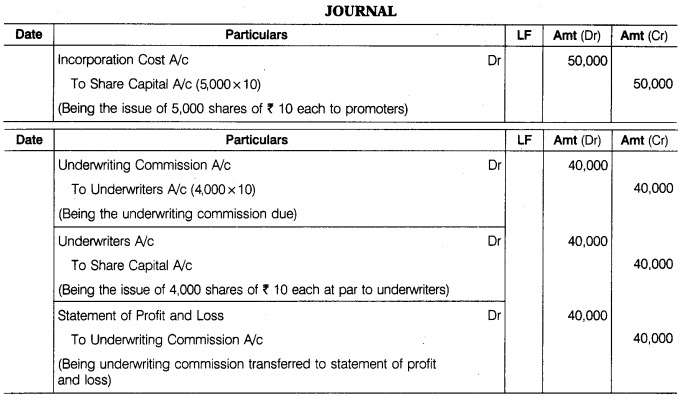
Or
XYZ Industries Ltd issued 2,000,10% debentures of ₹ 100 each, at a premium of ₹ 10 per debenture payable as follows On application ₹ 50; On allotment ₹ 60. The debentures were fully subscribed and all money was duly received. Record the journal entries in the books of company.
Answer:
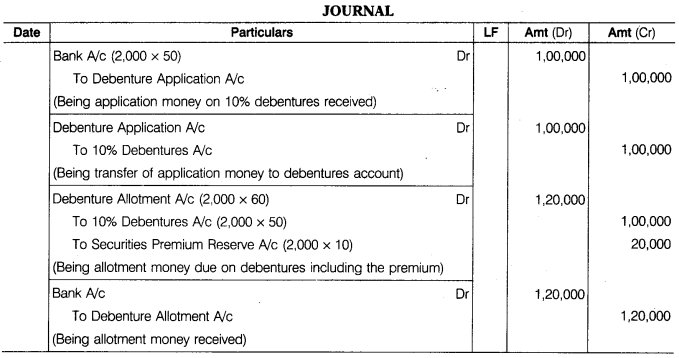
![]()
Question 18.
S and P are two partners in a firm sharing profit and losses in the ratio of 3: 2. At the time of distributing the net profit between the partners, interest on capital was credited @ 18 % instead of 8% wrongly. Partners’ capitals are given on 1st April, 2021 as ₹ 5,00,000 and ₹ 3,00,000 respectively. Profit on 31 st March, 2022 is ₹ 2,00,000. Following adjustment entry is passed to correct this error. Fill in the missing information in the following adjustment entry and give working notes. [3]
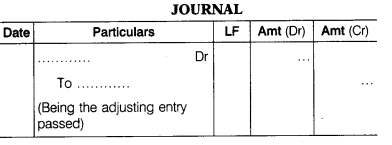
Answer:
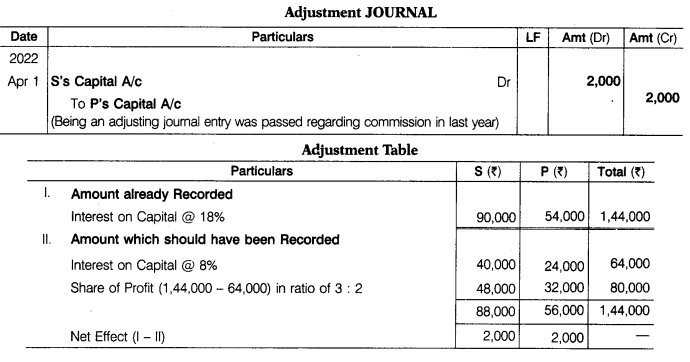
Question 19.
A and B are partners in a firm sharing profits and losses in the ratio of 2: 3. Their fixed capitals as on 1st April, 2018 were ₹ 3,00,000 and ₹ 4,00,000 respectively. As per partnership deed, both partners are to get monthly salary of ₹ 12,500 each and interest on capital @ 8% p.a. They are to be charged interest on drawings @ 10% p.a. Drawings during the year ended 31st March, 2019 were A ₹ 5,000 per month and B ₹ 60,000 during the year. Firm incurred a loss of ₹ 50,000 during the year before above adjustments. Prepare an account showing the distribution of profit/loss. [3]
Answer:

Working Notes
1. Interest on Drawings
A’s Drawings 5,000 x 12=60,000 x \(\frac{10}{100}\) x \(\frac{6}{12}\) = ₹ 3,000;
B’s Drawings = 60,000 x \(\frac{10}{100}\) x \(\frac{6}{12}\) = ₹ 3,000
In the absence of actual date of drawings, interest thereon has been calculated for an average period of 6 months.
2. Salary and interest on capital will not be provided in case of loss.
3. Although, profit and loss appropriation account is not prepared in case of loss, it has been prepared in this question because ‘Interest on Drawings’ is to be credited to this account.
![]()
Question 20.
Khushi, Avni and Reeta are partners sharing profits and losses in the ratio of 5: 3: 2 respectively. On 31st March, 2023 their balance sheet was as under.
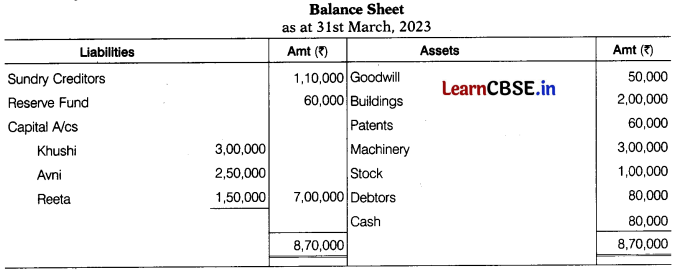
Reeta retires on the above date. Goodwill of the firm valued at ₹ 2,50,000.
Record the necessary journal entries on Reeta’s retirement, assuming that goodwill is to be adjusted through partner’s capital accounts. [3]
Answer:
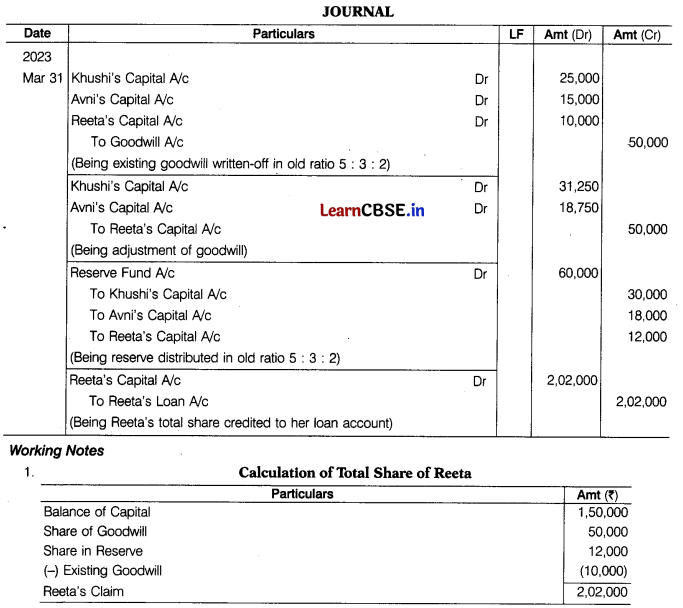
2. Reeta’s share of goodwill = 2/10 x 2,50,000 = ₹ 50,000 ; Gaining ratio = 5: 3
Or
Arun and Varun were partners sharing profits in 3:2 ratio. Their balance sheet on 31st March, 2023 was as follows:
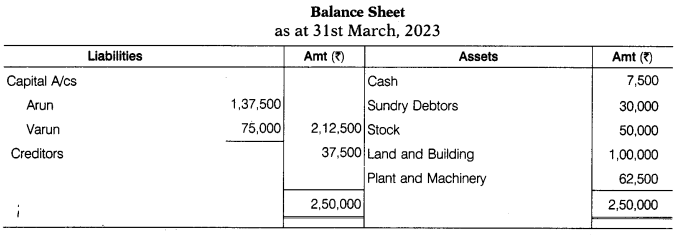
They admitted Tarun as partner on the following terms
(i) Tarun is to bring ₹ 62,500 as capital.
(ii) They will share future profits in 2: 2: 1 ratio.
(iii) Assets and liabilities are revalued as Land and building at ₹ 1,25,000, depreciate plant and machinery @ 10% per annum, provision for doubtful debts ₹ 2,500, stock at ₹ 45,000, ₹ 2,500 be reserved for bills discounted.
Show memorandum revaluation account.
Answer:
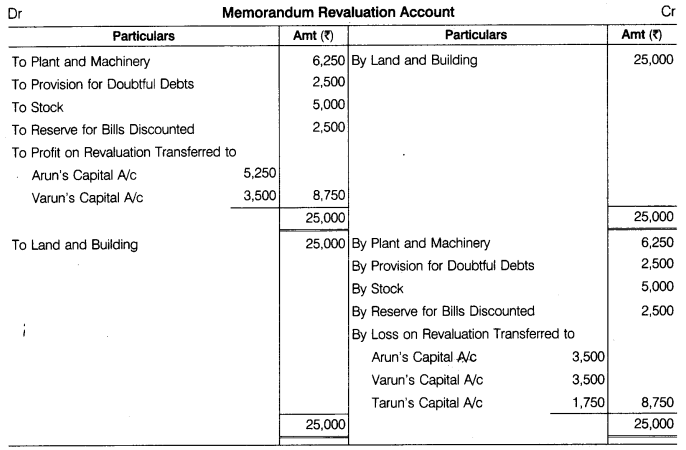
Question 21.
Raj, Ron and Kia were partners in a firm sharing profits and losses in the ratio of 3: 1: 1. On 1st April, 2022, their balance sheet stood as under
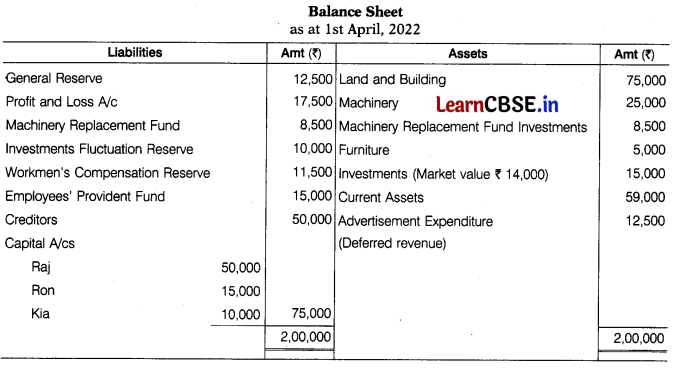
They admitted Vij into partnership for 1/5 th share of profits on the above date. A claim on account of workmen’s compensation is estimated at ₹ 6,500 only. Give the necessary journal entries to adjust the accumulated profits and losses. [4]
Answer:
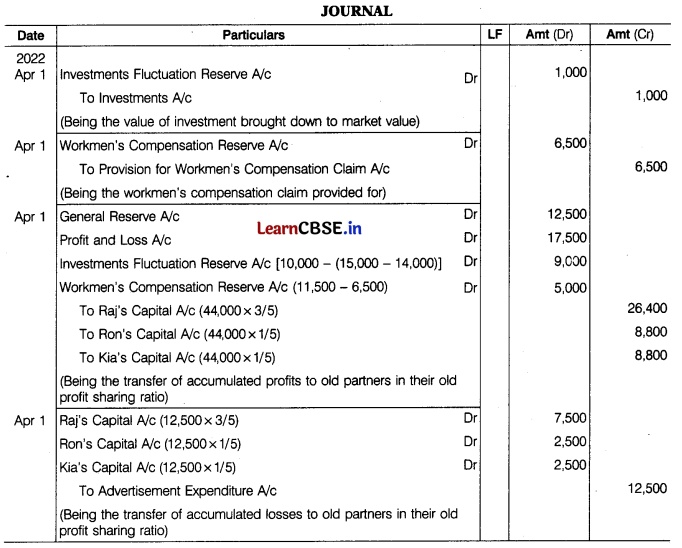
![]()
Question 22.
Cronic Ltd issued 10,000 equity shares of ₹ 10 each payable at ₹ 2.50 on application, ₹ 3 on allotment, ₹ 2 on first call and the balance of ₹ 2.50 on the final call. All the shares were fully subscribed and paid except of a shareholder having 100 shares who could not pay for the final call. Give journal entries to record these transactions.
Answer:
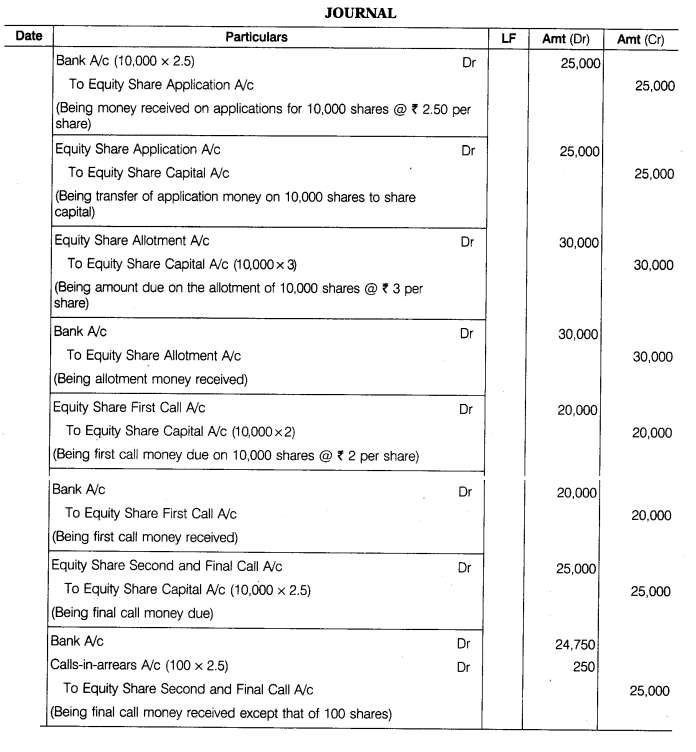
Question 23.
Paramount Ltd. issued 2,500,9% debentures of ₹ 100 each at par for cash which are redeemable at 10% premium and also raised a loan of ₹ 80,000 from Asian Bank, for which the company placed with the bank ₹ 50,000,9% debentures as collateral security. As per the terms, the bank is obliged and bound to immediately release the debentures, as soon as the loan is repaid. How will you show the debentures in the balance sheet of the company assuming that the company has recorded the issue of debentures as collateral in the books? Also pass the journal entries.
Answer:
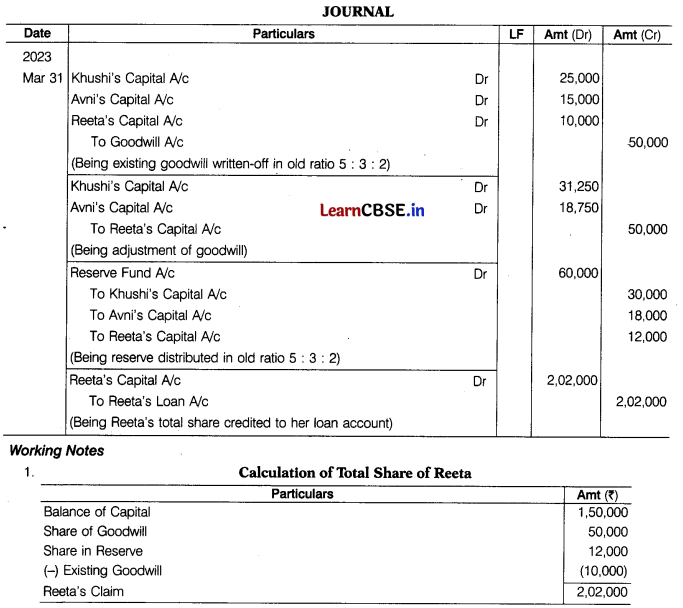
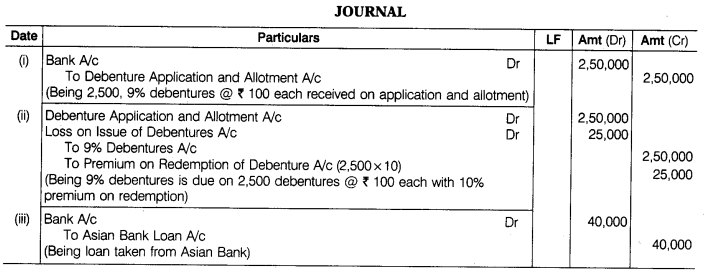
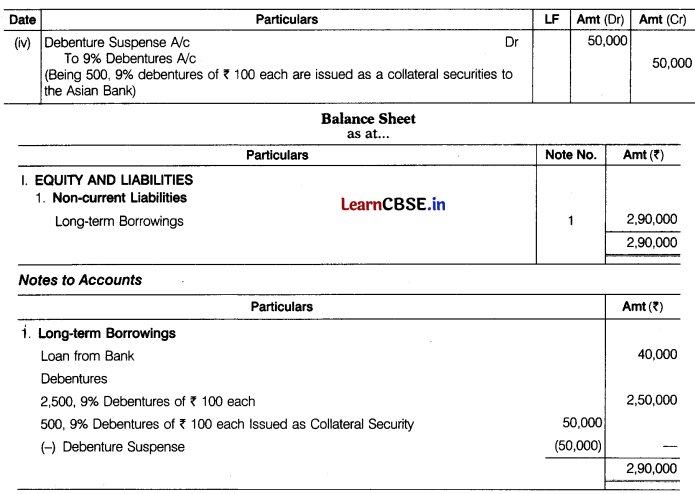
Question 22.
Cronic Ltd issued 10,000 equity shares of ₹ 10 each payable at ₹ 2.50 on application, ₹ 3 on allotment, ₹ 2 on first call and the balance of ₹ 2.50 on the final call. All the shares were fully subscribed and paid except of a shareholder having 100 shares who could not pay for the final call. Give journal entries to record these transactions. [4]
Answer:
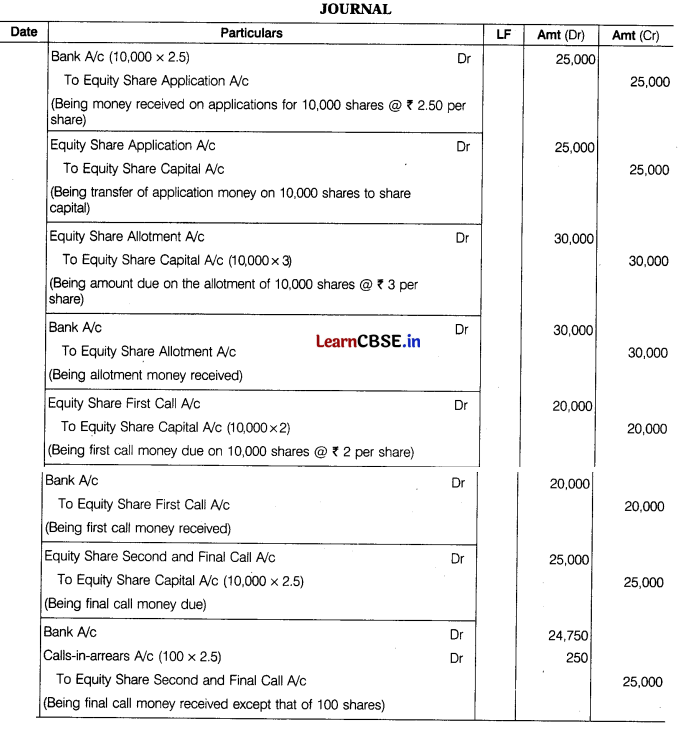
![]()
Question 23.
Paramount Ltd. issued 2,500,9% debentures of ₹ 100 each at par for cash which are redeemable at 10% premium and also raised a loan of ₹ 80,000 from Asian Bank, for which the company placed with the bank ₹ 50,000,9% debentures as collateral security. As per the terms, the bank is obliged and bound to immediately release the debentures, as soon as the loan is repaid. How will you show the debentures in the balance sheet of the company assuming that the company has recorded the issue of debentures as collateral in the books? Also pass the journal entries.
Answer:
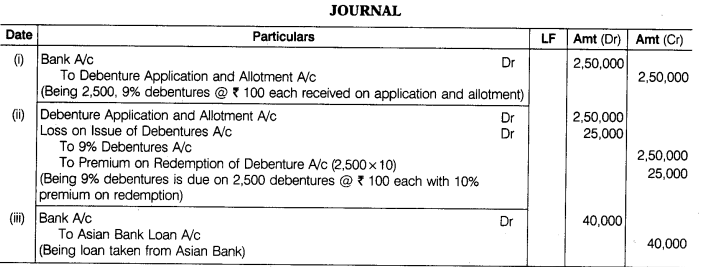
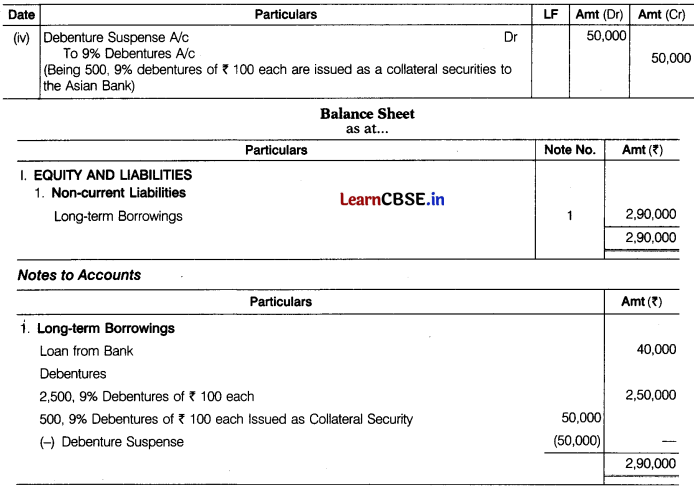
Question 24.
DEF Company Ltd offered for public subscription 10,000 shares of ₹ 10 each at ₹ 11 per share. Money was payable as follows
₹ 3 on application, ₹ 4 on allotment (including premium), ₹ 4 on first and final call. Applications were received for 12,000 shares and the directors made pro-rata allotment. Akansha, an applicant for 120 shares, could not pay the allotment and call money and Shalu, a holder of 200 shares, failed to pay the call. All these shares were forfeited. Out of the forfeited shares, 150 shares (the whole of Akansha shares being included) were issued at ₹ 8 per share. Record journal entries for the above transactions and prepare the share forfeiture account.
Or
Hindustan Ltd. invited application for 1,40,000 equity shares of ₹ 10 each payable as under
On application ₹ 2 On first call ₹ 3
On allotment ₹ 2 On final call ₹ 3
Applications were received for 2,10,000
shares and pro-rata allotment was made to all the applicants.
All the shareholders paid the amount due with the following exception
(i) Rajeev, who was allotted 1,400 shares, failed to pay the allotment and calls.
(ii) Sanjeev, who was allotted 1,050 shares paid only application and allotment.
These shares were forfeited and subsequently 1,800 shares were reissued as fully paid at a discount of 20%. Shares reissued include 1,000 shares of Rajeev and 800 shares of Sanjeev.
Pass necessary journal entries.
Answer:
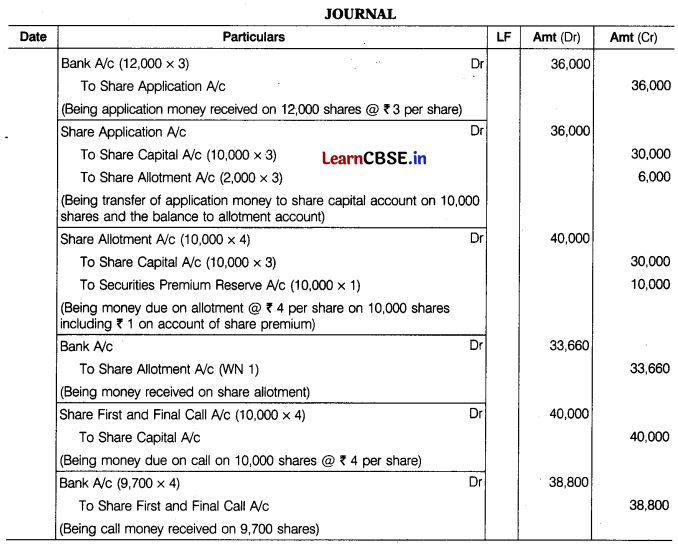
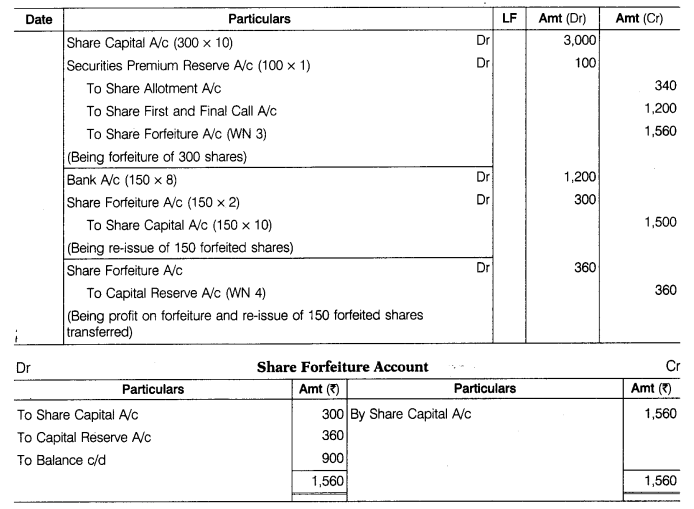
Working Notes:

2. Securities premium account has been debited only with ₹ 100 relating to 100 shares allotted to Akansha from whom the allotment money (including premium) has not been received.
3. Shares forfeited account represents the money received on forfeited shares excluding share premium. This has been worked-out as follows

Or
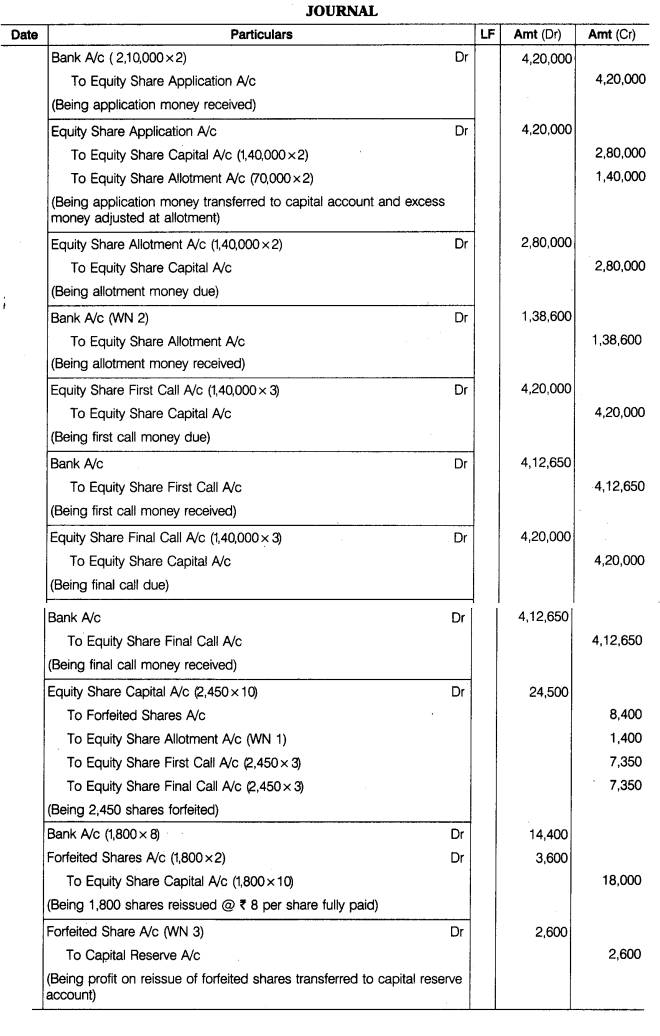
![]()
Working Notes:
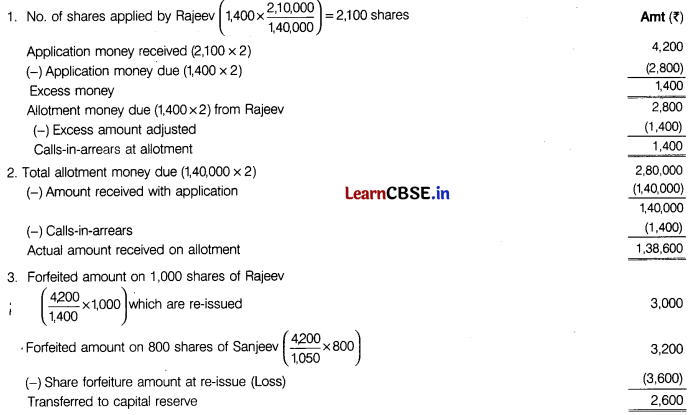
Question 25.
S and T were partners from 1st April, 2021 with capitals of ₹ 1,20,000 and ₹ 80,000 respectively. They shared profits in the ratio of 3: 2. They carried on business for two years.
In the first year ended 31st March, 2022, they earned a profit of ₹ 1,00,000 but in the second year ended 31st March, 2023, a loss of ₹ 40,000 was incurred.
As the business was no longer profitable, they dissolved the firm on 31st March, 2023.
Their balance sheet is as follows
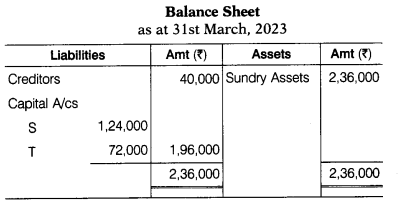
Sundry assets realised ₹ 2,00,000 and realisation expenses were ₹ 6,000.
You are required to prepare realisation account, partner’s capital account and cash account. [6]
Answer:
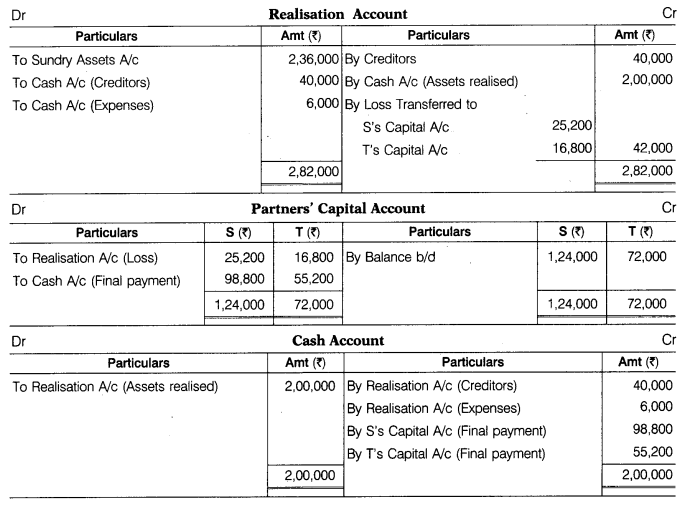
![]()
Question 26.
Anuj, Vishal and Shekhar were equal partners. Their balance sheet as at 31st March, 2022 was
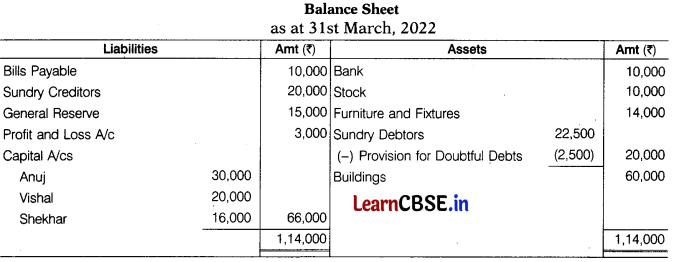
Vishal retired on 1st April, 2022. Anuj and Shekhar decided to continue the business as equal partners on the following terms
(i) Goodwill of the firm was valued at ₹ 28,800
(ii) The provision for bad and doubtful debts to be maintained @ 10% on debtors.
(iii) Buildings to be increased to ₹ 66,000
(iv) Furniture and fixtures to be reduced by ₹ 4,000.
(v) Rent outstanding (not provided for as yet) was ₹ 750
The partners decided to bring in sufficient cash in the business to pay-off Vishal. For this purpose, Anuj brought ₹ 12,250 and Shekhar ₹ 26,250.
Prepare the necessary ledger accounts and the balance sheet.
Answer:
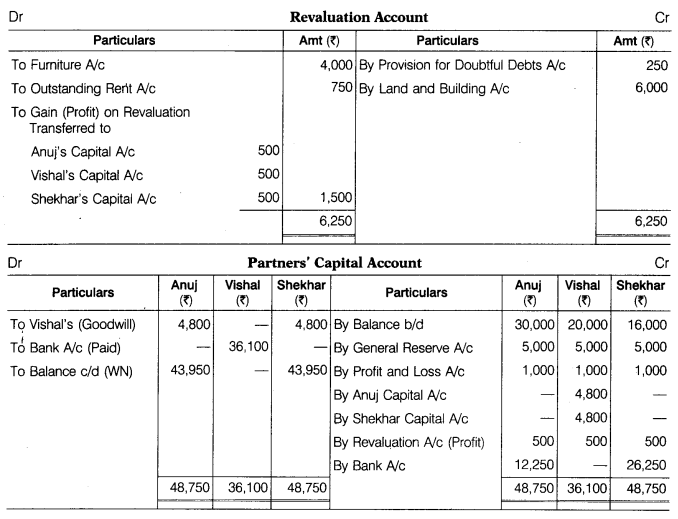
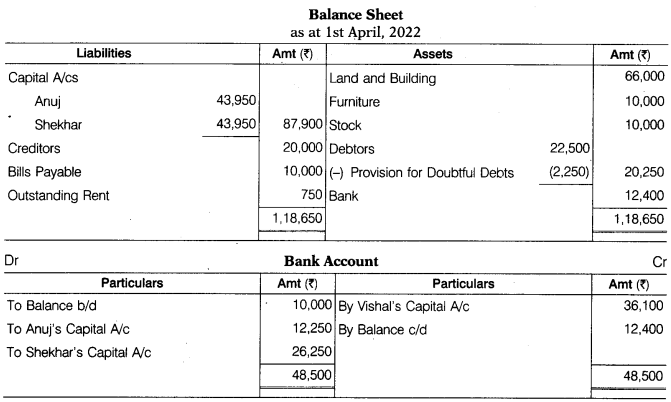
Or
Anita and Sanjay are partners dealing in manufacturing plastic polythenes, with profit sharing ratio of 2: 1. Their balance sheet as at 31 st March, 2022 was as under, when the government banned the plastic polythene and therefore, they shifted to manufacturing paper bags.
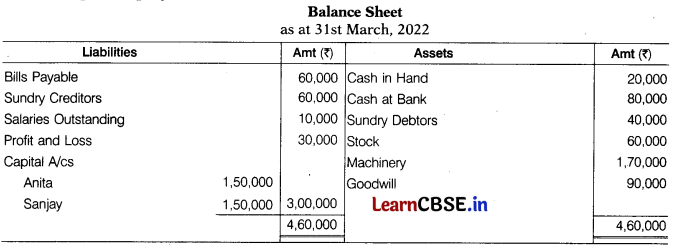
They admitted Sonu into partnership on 1st April, 2022. The new profit sharing ratio is agreed as 2: 1: 1. Other terms of Sonu’s admission were as under
(i) He will bring in ₹ 1,20,000, through cheque, as his share of capital and ₹ 30,000 as his share of goodwill.
(ii) Machinery is to be appreciated by 10%.
(iii) Stock overvalued by ₹ 2,000
(iv) A provision for doubtful debts is to be created at 5 % on debtors.
(v) Creditors are unrecorded to the extent of ₹ 7,000.
Prepare the revaluation account, partners’ capital accounts, bank account and the balance sheet of the new firm after the admission.
Answer:

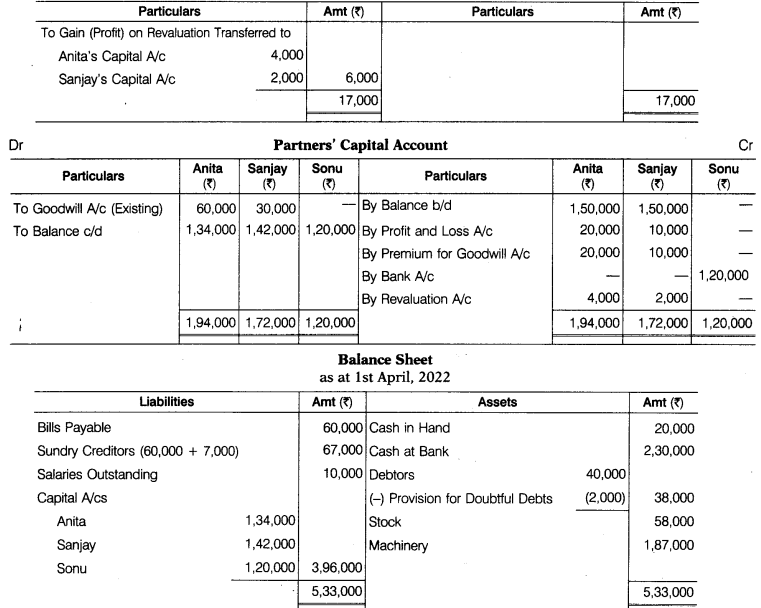
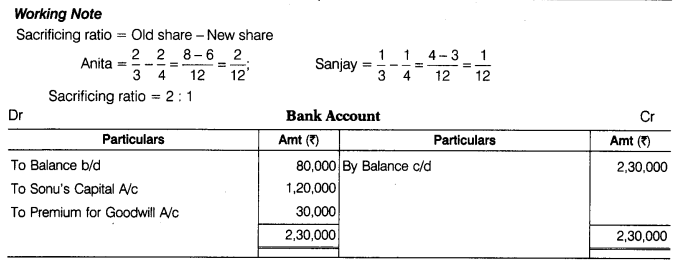
Part B
(Financial Statement Analysis)
Question 27.
Livestock is an item of assets under sub-head fixed assets and the major head non-current assets.
(a) intangible
(b) inver
(c) trade receivables
(d) tangible
Answer:
(d) tangible
Or
Ratio analysis under financial statement analysis is significant as it
(a) helps in window-dressing
(b) does not requires any standards
(c) ignores qualitative factors
(d) helps in locating weak points of the firm
Answer:
(d) helps in locating weak points of the firm
Question 28.
If current assets are ₹ 1,00,000, current liabilities are ₹ 50,000, inventories ₹ 6,000 and prepaid expenses ₹ 10,000, what is the value of quick assets?
(a) ₹ 50,000
(b) ₹ 94,000
(c) ₹ 90,000
(d) ₹ 84,000
Answer:
(d) Quick Assets = Current Assets — Inventories — Prepaid Expenses = 1,00,000 — 000 — 10,000 = 84,000
Question 29.
For a company manufacturing garments, procurement of raw material, incurrence of manufacturing expenses, sale of garments are classified as ……………….
(a) financing
(b) investing
(c) operating activity.
Answer:
(c) operating activity.
Or
Statement I Cash flow statement is not a replacement of fund flow statement.
Statement II Cash flow statement is a substitute of income statement.
Alternatives
(a) Both the statement are true
(b) Both the statements are false
(c) Statement I is true and Statement II is false
(d) Statement II is true and Statement I is false
Answer:
(c) Statement I is true and Statement II is false
Question 30.

Additional Information
Proposed Dividend 2023 ₹ 1,00,000;2022 ₹ 62,500
Based on above information given, you are required to find out the value of ‘net profit before tax and extraordinary items’ to be used while preparing cash flow statement. [1]
(a) ₹ 1,25,000
(b) ₹ 50,000
(c) ₹ 2,25,000
(d) ₹ 1,37,500
Answer:

Question 31.
Under which head and sub-head will the following items appear in the balance sheet of a company?
(i) Share option outstanding account
(ii) Interest accrued and due on secured loans
(iii) Advances recoverable in cash
Answer:

Question 32.
From the following balance sheets of Verma Ltd, prepare comparative balance sheet.
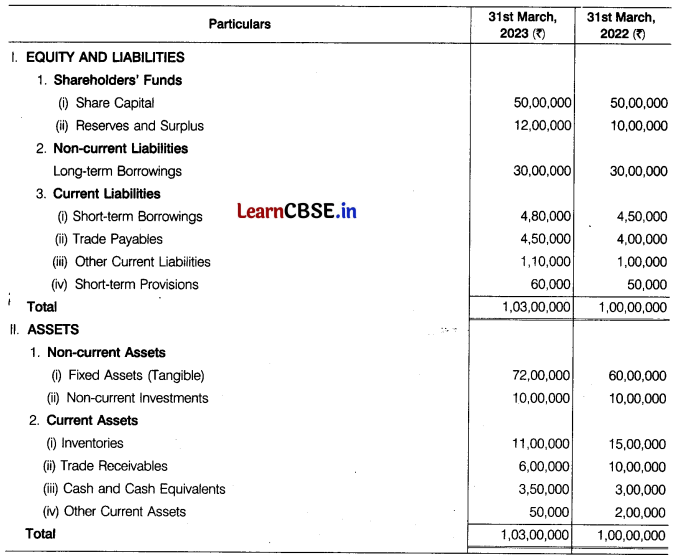
Answer:
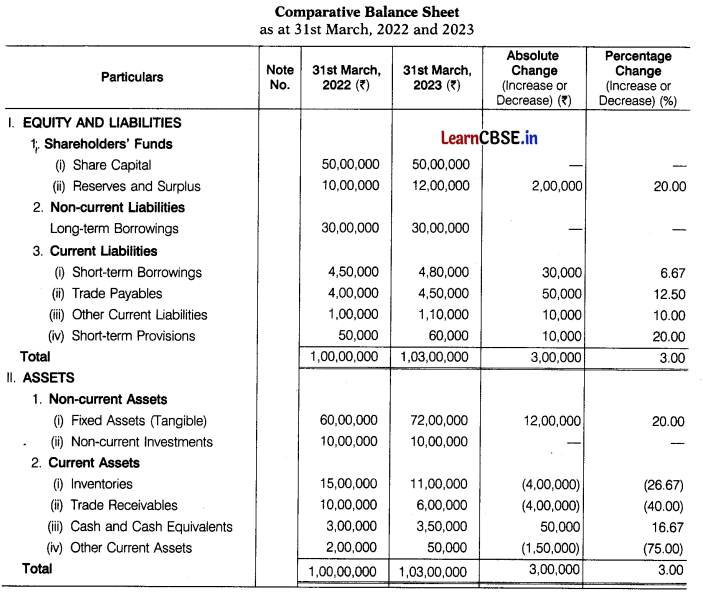
Question 33.
From the following balance sheet of Kushal Ltd. as at 31st March, 2022 and additional information, calculate the debtors’ turnover ratio and debt collection period.
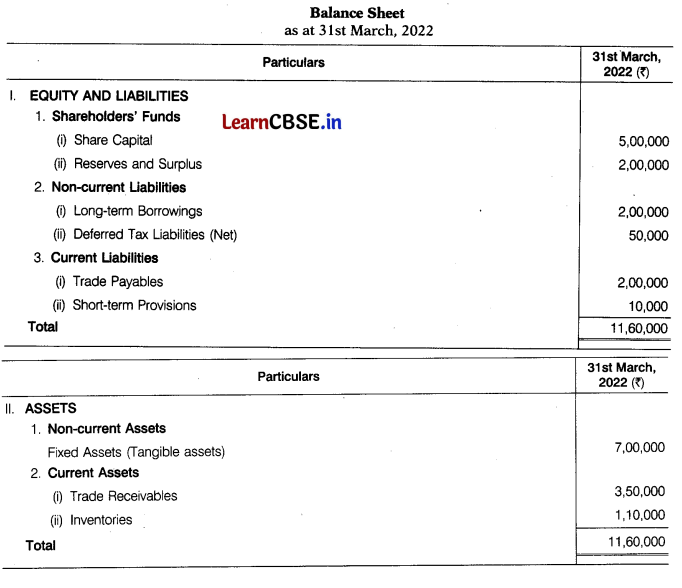
Additional Information
(i) Credit sales of ₹ 15,00,000 and cash sales of ₹ 2,50,000.
(ii) Trade receivables in the beginning of the year were ₹ 4,50,000.
Answer:

Or
Calculate trade receivables turnover ratio from the following information
Cost of revenue from operations ₹ 4,50,000, Gross profit on sales 20%, Cash sales 25% of net credit sales, Opening trade receivables ₹ 60,000, Closing trade receivables ₹ 90,000.
Answer:
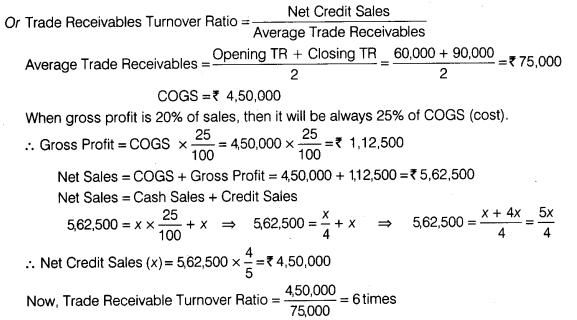
Question 34.
Radhika an alumni of Apex School initiated her startup Vortex Ltd. in 2021. The net profit after tax of Vortex Ltd. for the year ended 31st March, 2022 was ₹ 3,40,000. Following is the extract of Balance Sheet of Vortex Ltd. as at 31st March, 2022

Answer:
